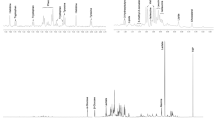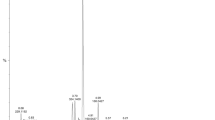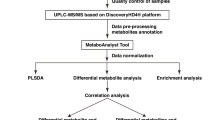Abstract
We hypothesized that placental resistance was elevated and transfer reduced in cotyledons from intrauterine growth-restricted (IUGR) fetuses. We perfused 10 cotyledons from term, normally grown fetuses, six from preterm, normally grown fetuses with normal umbilical arterial end-diastolic velocities (EDV), and six from preterm IUGR fetuses (<3rd centile) with absent or reversed umbilical arterial EDV. Perfused cotyledons were pressure-fixed, and villi were observed by scanning electron microscopy. The groups did not differ in fetoplacental resistance at baseline; neither did they differ in the change in resistance that followed the administration of nitroglycerin or angiotensin II. The increase in resistance during hypoxia was similar in the two preterm groups but greater in the term than in the preterm normally grown group (p < 0.05). Groups did not differ in net maternofetal transfer of oxygen or glucose, or in clearance of aminoisobutyric acid or antipyrine. However, glucose consumption was doubled in cotyledons of preterm IUGR versus preterm normally grown fetuses (p < 0.05). Terminal villi of perfused cotyledons from preterm IUGR fetuses displayed less terminal villous branching and budding than preterm controls, as anticipated from previous work. IUGR fetuses with absent or reversed umbilical arterial EDV in vivo may have high placental resistance due to a vasoconstrictive rather than anatomic abnormality and an elevated placental glucose consumption that may impair glucose transfer.
Similar content being viewed by others
Log in or create a free account to read this content
Gain free access to this article, as well as selected content from this journal and more on nature.com
or
Abbreviations
- AIB:
-
aminoisobutyric acid
- EDV:
-
end-diastolic velocity
- IUGR:
-
intrauterine growth restriction
- PI:
-
preterm IUGR
- PN:
-
preterm normally grown
- TN:
-
term normally grown
References
Gill RW, Kossoff G, Warren PS, Garrett WJ 1984 Umbilical venous flow in normal and complicated pregnancy. Ultrasound Med Biol 10: 349–363
Krebs C, Macara LM, Leiser R, Bowman AW, Greer IA, Kingdom JC 1996 Intrauterine growth restriction with absent end-diastolic flow velocity in the umbilical artery is associated with maldevelopment of the placental terminal villous tree. Am J Obstet Gynecol 175: 1534–1542
Giles WB, Trudinger BJ, Baird PJ 1985 Fetal umbilical artery flow velocity waveforms and placental resistance: pathological correlation. Br J Obstet Gynaecol 92: 31–38
McCowan LM, Mullen BM, Ritchie K 1987 Umbilical artery flow velocity waveforms and the placental vascular bed. Am J Obstet Gynecol 157: 900–902
Jackson MR, Walsh AJ, Morrow RJ, Mullen JBM, Lye SJ, Ritchie JWK 1995 Reduced placental villous tree elaboration in small-for-gestational-age pregnancies: relationship with umbilical artery Doppler waveforms. Am J Obstet Gynecol 172: 518–525
Macara L, Kingdom JCP, Kohnen G, Bowman AW, Greer IA, Kaufmann P 1995 Elaboration of stem villous vessels in growth restricted pregnancies with abnormal umbilical artery Doppler waveforms. Br J Obstet Gynaecol 102: 807–812
Morris NH, Sooranna SR, Learmont JG, Poston L, Ramsey B, Pearson JD, Steer PJ 1995 Nitric oxide synthase activities in placental tissue from normotensive, pre-eclamptic and growth retarded pregnancies. Br J Obstet Gynaecol 102: 711–714
Harvey-Wilkes KB, Nielsen HC, D'Alton ME 1996 Elevated endothelin levels are associated with increased placental resistance. Am J Obstet Gynecol 174: 1599–1604
McQueen J, Kingdom JCP, Connell JMC, Whittle MJ 1993 Fetal endothelin levels and placental vascular endothelin receptors in intrauterine growth retardation. Obstet Gynecol 82: 992–998
Kingdom JCP, McQueen J, Connell JMC, Whittle MJ 1993 Fetal angiotensin II levels and vascular (type I) angiotensin receptors in pregnancies complicated by intrauterine growth retardation. Br J Obstet Gynaecol 100: 476–482
Pardi G, Cetin I, Marconi AM, Bozzetti P, Buscaglia M, Makowski EL, Battaglia FC 1992 Venous drainage of the human uterus: respiratory gas studies in normal and fetal growth-retarded pregnancies. Am J Obstet Gynecol 166: 699–706
Marconi AM, Paolini C, Buscaglia M, Zerbe G, Battaglia FC, Pardi G 1996 The impact of gestational age and fetal growth on the maternal-fetal glucose concentration difference. Obstet Gynecol 87: 937–942
Nicolaides KH, Economides DL, Soothill PW 1989 Blood gases, pH, and lactate in appropriate- and small-for-gestational-age fetuses. Am J Obstet Gynecol 161: 996–1001
Economides DL, Nicolaides KH, Campbell S 1991 Metabolic and endocrine findings in appropriate and small for gestational age fetuses. J Perinat Med 19: 97–105
Marconi AM, Cetin I, Ferrazzi E, Ferrari MM, Pardi G, Battaglia FC 1990 Lactate metabolism in normal and growth-retarded human fetuses. Pediatr Res 28: 652–656
Economides DL, Nicolaides KH, Gahl WA, Bernardini I, Evans MI 1989 Plasma amino acids in appropriate- and small-for-gestational-age fetuses. Am J Obstet Gynecol 161: 1219–1227
Cetin I, Ronzoni S, Marconi AM, Perugino G, Corbetta C, Battaglia FC, Pardi G 1996 Maternal concentrations and fetal-maternal concentration differences of plasma amino acids in normal and intrauterine growth-restricted pregnancies. Am J Obstet Gynecol 174: 1575–1583
Józwik M, Teng C, Timmerman M, Chung M, Meschia G, Battaglia FC 1998 Uptake and transport by the ovine placenta of neutral nonmetabolizable amino acids with different transport system affinities. Placenta 19: 531–538
Dicke JM, Henderson GI 1988 Rapid communication: placental amino acid uptake in normal and complicated pregnancies. Am J Med Sci 295: 223–227
Glazier JD, Cetin I, Perugino G, Ronzoni S, Grey AM, Mahendran D, Marconi AM, Pardi G, Sibley CP 1997 Association between the activity of the system A amino acid transporter in the microvillous plasma membrane of the human placenta and severity of fetal compromise in intrauterine growth restriction. Pediatr Res 42: 514–519
Mahendran D, Donnai P, Glazier JD, D'Souza SW, Boyd RDH, Sibley CP 1993 Amino acid (system A) transporter activity in microvillous membrane vesicles from the placentas of appropriate and small for gestational age babies. Pediatr Res 34: 661–665
Byrne BM, Howard RB, Morrow RJ, Whiteley KJ, Adamson SL 1997 Role of the L-arginine nitric oxide pathway in hypoxic fetoplacental vasoconstriction. Placenta 18: 627–634
Adamson SL, Whiteley KJ, Langille BL 1992 Pulsatile pressure-flow relations and pulse-wave propagation in the umbilical circulation of fetal sheep. Circ Res 70: 761–772
Myatt L, Brewer A, Brockman DE 1991 The action of nitric oxide in the perfused human fetal-placental circulation. Am J Obstet Gynecol 164: 687–692
Brodie BB, Axelrod J, Soberman R, Levy BB 1949 The estimation of antipyrine in biological materials. J Biol Chem 179: 25–29
Schneider H, Challier J-C, Dancis J 1981 Transfer and metabolism of glucose and lactate in the human placenta studied by a perfusion system in vitro. In: Young M, Boyd RDH, Longo LD, Telegdy G (eds) Placental Transfer: Methods and Interpretation. Placenta (Supplement 2). W.B. Saunders Company Ltd., London, East Sussex, pp 129–137
Clifton VL, Read MA, Leitch IM, Giles WB, Boura ALA, Robinson PJ, Smith R 1995 Corticotropin-releasing hormone-induced vasodilation in the human fetal-placental circulation involvement of the nitric oxide-cyclic guanosine 3′,5′-monophosphate-mediated pathway. J Clin Endocrinol Metab 80: 2888–2893
St John Sutton MS, Theard MA, Bhatia SJS, Plappert T, Saltzman DH, Doubilet P 1990 Changes in placental blood flow in the normal human fetus with gestational age. Pediatr Res 28: 383–387
Adamson SL, Morrow RJ, Langille BL, Bull SB, Ritchie JWK 1990 Site-dependent effects of increases in placental vascular resistance on the umbilical arterial velocity waveform in fetal sheep. Ultrasound Med Biol 16: 19–27
Surat DR, Adamson SL 1996 Downstream determinants of pulsatility of the mean velocity waveform in the umbilical artery as predicted by a computer model. Ultrasound Med Biol 22: 707–717
Salafia CM, Pezzullo JC, Minior VK, Divon MY 1997 Placental pathology of absent and reversed end-diastolic flow in growth-restricted fetuses. Obstet Gynecol 90: 830–836
Morrow RJ, Adamson SL, Bull SB, Ritchie JWK 1989 Effect of placental embolization on the umbilical arterial velocity waveform in fetal sheep. Am J Obstet Gynecol 161: 1055–1060
van Vugt JMG, Hasaart THM, Ruissen CJ, Hoogland HJ, Hoeks APG, de Haan J 1988 Pulsatility index and its relationship to placental vascular resistance during partial umbilical venous occlusion: a study in fetal lambs. Gynecol Obstet Invest 26: 1–7
Howard RB, Hosokawa T, Maguire MH 1987 Hypoxia-induced fetoplacental vasoconstriction in perfused human placental cotyledons. Am J Obstet Gynecol 157: 1261–1266
Karimu AL, Burton GJ 1994 The effects of maternal vascular pressure on the dimensions of the placental capillaries. Br J Obstet Gynaecol 101: 57–63
Jansson T, Wennergren M, Illsley NP 1993 Glucose transporter protein expression in human placenta throughout gestation and in intrauterine growth retardation. J Clin Endocrinol Metab 77: 1554–1562
Thaler I, Amit A, Jakobi P, Itskovitz-Eldor J 1996 The effect of isosorbide dinitrate on uterine artery and umbilical artery flow velocity waveforms at mid-pregnancy. Obstet Gynecol 88: 838–843
Kainulainen H, Jarvinen T, Heinonen PK 1997 Placental glucose transporters in fetal intrauterine growth retardation and macrosomia. Gynecol Obstet Invest 44: 89–92
Malek A, Sager R, Altermatt HJ, Gaeng D, Leiser R, Schneider H 1996 Glucose consumption and lactate production of human placental tissue under different conditions of in vitro incubation. J Soc Gynecol Investig 3: 113–120
Illsley NP, Penfold P, Bardsley SE, Tracey BM, Aarnoudse JG 1983 The effects of anoxia on human placental metabolism and fetal substrate profiles investigated by an in vitro placental perfusion technique. Trophoblast Res 1: 55–70
Acknowledgements
The authors thank Kathey Whiteley, Brenda Knie, Alexsandra Pastrakuljic, Carmine Simone, and Bridgette Byrne for their advice and technical support, and Dr. Angelo Tesoro for HPLC analysis of AIB concentrations. We also thank Lindsay McWhirter and the delivery suite staff of Mount Sinai Hospital for their invaluable assistance in obtaining placentas.
Author information
Authors and Affiliations
Additional information
Supported by a grant from the Medical Research Council of Canada. S.L.A. received support as a Career Investigator of the Heart and Stroke Foundation of Ontario.
Rights and permissions
About this article
Cite this article
Challis, D., Pfarrer, C., Ritchie, J. et al. Glucose Metabolism Is Elevated and Vascular Resistance and Maternofetal Transfer Is Normal in Perfused Placental Cotyledons from Severely Growth-Restricted Fetuses. Pediatr Res 47, 309–315 (2000). https://doi.org/10.1203/00006450-200003000-00005
Received:
Accepted:
Issue date:
DOI: https://doi.org/10.1203/00006450-200003000-00005



